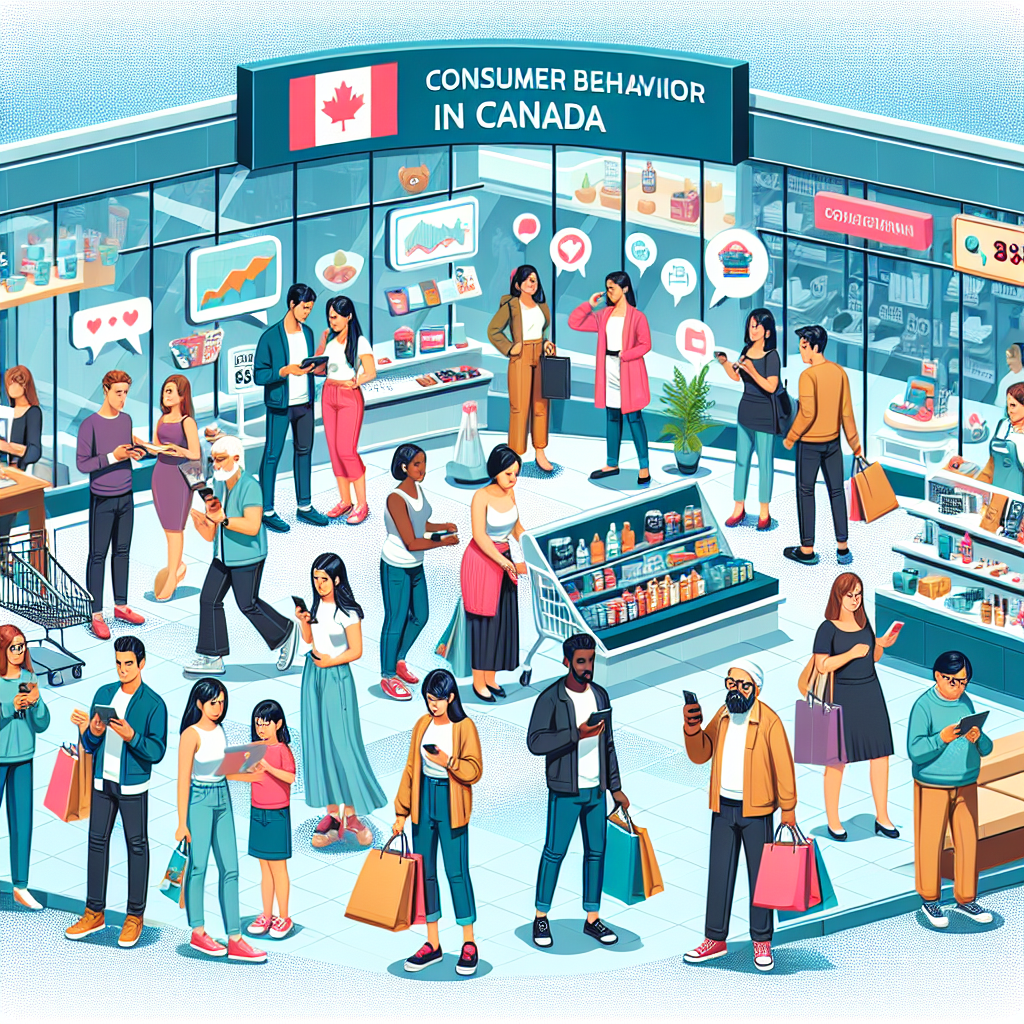Exploring the Dynamics of Consumer Behavior in Canada
Understanding consumer behavior is a critical aspect of successful marketing and business strategy. In Canada, the dynamics of consumer behavior are shaped by a variety of factors, including cultural diversity, economic conditions, and technological advancements. This article aims to explore these dynamics and provide insights into the Canadian consumer market.
Canada is a multicultural country with a high degree of cultural diversity. This diversity is reflected in the consumer behavior of Canadians, who exhibit a wide range of preferences and buying habits. For instance, Canadians of different cultural backgrounds may have different tastes in food, clothing, and entertainment, which can influence their purchasing decisions. Therefore, businesses operating in Canada need to be aware of these cultural differences and tailor their products and marketing strategies accordingly.
Economic conditions also play a significant role in shaping consumer behavior in Canada. During periods of economic growth, consumers tend to have higher disposable incomes and are more likely to make discretionary purchases. On the other hand, during periods of economic downturn, consumers may become more price-sensitive and prioritize essential purchases over luxury items. Therefore, understanding the current economic climate and its impact on consumer spending habits is crucial for businesses.
Technological advancements have significantly influenced consumer behavior in Canada. The rise of e-commerce and digital marketing has transformed the way Canadians shop and interact with brands. Many Canadians now prefer to shop online due to the convenience and variety it offers. This shift towards online shopping has been further accelerated by the COVID-19 pandemic, which has led to increased use of digital platforms for shopping and entertainment. As a result, businesses need to adapt to these changes and develop effective online marketing strategies to reach their target audience.
In addition to these factors, consumer behavior in Canada is also influenced by social trends and environmental concerns. Canadians are becoming increasingly conscious of the social and environmental impact of their purchases. This has led to a growing demand for sustainable and ethically produced products. Businesses that can demonstrate their commitment to sustainability and social responsibility are likely to appeal to these environmentally conscious consumers.
Furthermore, the aging population in Canada is another important factor to consider. As the population ages, there is a growing demand for products and services that cater to the needs of older adults. Businesses that can cater to this demographic are likely to see increased sales and customer loyalty.
In conclusion, understanding consumer behavior in Canada requires a comprehensive understanding of the various factors that influence it. These include cultural diversity, economic conditions, technological advancements, social trends, environmental concerns, and demographic changes. By understanding these dynamics, businesses can develop effective marketing strategies and products that meet the needs and preferences of Canadian consumers. This, in turn, can lead to increased customer satisfaction, loyalty, and ultimately, business success.
The Impact of Cultural Diversity on Consumer Behavior in Canada

Understanding consumer behavior is a critical aspect of successful marketing. In Canada, a country known for its cultural diversity, understanding consumer behavior becomes even more complex yet intriguing. The cultural diversity in Canada significantly impacts consumer behavior, shaping purchasing decisions and market trends.
Canada is a multicultural society, home to people from various ethnic backgrounds. This cultural diversity is a result of the country’s liberal immigration policies and its history of welcoming refugees and immigrants from around the world. The multicultural nature of Canadian society has led to a rich tapestry of consumer behaviors, influenced by a myriad of cultural norms, values, and traditions.
One of the most significant ways cultural diversity impacts consumer behavior in Canada is through the influence of cultural values on purchasing decisions. Different cultures have different values, and these values often dictate what products or services are considered desirable or necessary. For instance, in cultures where family is highly valued, products and services that enhance family bonding or facilitate family activities may be more popular. Similarly, in cultures where individualism is highly valued, products and services that promote personal growth and self-expression may be more sought after.
Another way cultural diversity impacts consumer behavior in Canada is through the influence of cultural traditions on consumption patterns. Cultural traditions often dictate when and how certain products or services are consumed. For instance, during certain cultural festivals or celebrations, there may be an increased demand for specific types of food, clothing, or other goods. Understanding these cultural traditions can help businesses anticipate changes in demand and adjust their marketing strategies accordingly.
Cultural diversity also impacts consumer behavior in Canada through the influence of language. Canada is a bilingual country, with English and French as its official languages. However, many other languages are spoken by different ethnic communities across the country. Language can influence consumer behavior in several ways. For instance, consumers may prefer to shop at businesses where their language is spoken or where product information is available in their language. Additionally, language can influence the perception of a brand or product. Brands that can effectively communicate in the language of their target consumers can create a stronger connection and foster brand loyalty.
Lastly, cultural diversity can impact consumer behavior in Canada through the influence of social norms. Social norms, which are often shaped by cultural beliefs and values, can dictate what is considered acceptable or desirable behavior. This can influence consumer behavior in various ways, from what products or services are considered appropriate to purchase, to how consumers interact with businesses.
In conclusion, the cultural diversity in Canada significantly impacts consumer behavior, influencing everything from purchasing decisions to consumption patterns. Understanding these influences is crucial for businesses seeking to succeed in the Canadian market. By taking into account the cultural values, traditions, languages, and social norms of their target consumers, businesses can develop more effective marketing strategies and build stronger connections with their customers.
Evolving Trends in Canadian Consumer Behavior: A Comprehensive Analysis
Understanding consumer behavior is a critical aspect of successful marketing and business strategy. In Canada, consumer behavior has been evolving rapidly, influenced by various factors such as technological advancements, demographic shifts, and changing societal norms. This article provides a comprehensive analysis of the evolving trends in Canadian consumer behavior.
One of the most significant trends in Canadian consumer behavior is the increasing reliance on digital technology. With the advent of the internet and smartphones, consumers have access to a wealth of information at their fingertips. They can compare prices, read reviews, and make purchases from the comfort of their homes. This has led to a shift in the way consumers make purchasing decisions. They are no longer solely reliant on traditional advertising and sales pitches; instead, they are increasingly turning to online resources to inform their decisions. This trend has been further accelerated by the COVID-19 pandemic, which has forced many consumers to turn to online shopping due to lockdowns and social distancing measures.
Another key trend is the growing importance of sustainability and ethical considerations in consumer behavior. Canadian consumers are becoming more conscious of the environmental and social impacts of their purchasing decisions. They are increasingly seeking out products and services that are environmentally friendly, ethically sourced, and socially responsible. This trend is particularly pronounced among younger consumers, who are often more willing to pay a premium for sustainable and ethical products.
Demographic shifts are also influencing consumer behavior in Canada. The country’s population is aging, with the proportion of people aged 65 and over expected to surpass the proportion of children under 15 for the first time in history. This has significant implications for consumer behavior, as older consumers tend to have different purchasing habits and preferences than younger consumers. For example, they may prioritize convenience and quality over price, and they may be less likely to shop online.
At the same time, Canada’s population is becoming more diverse, with an increasing number of immigrants and visible minorities. This diversity is reflected in consumer behavior, with different cultural groups having different purchasing habits and preferences. For example, some cultural groups may place a high value on brand loyalty, while others may prioritize price or quality.
Finally, societal norms and values are changing, and this is reflected in consumer behavior. For example, there is a growing acceptance of non-traditional lifestyles and identities, such as LGBTQ+ identities. This is leading to increased demand for products and services that cater to these identities, such as gender-neutral clothing and beauty products.
In conclusion, understanding consumer behavior in Canada requires a comprehensive analysis of various factors, including technological advancements, demographic shifts, and changing societal norms. By staying abreast of these evolving trends, businesses can better meet the needs and preferences of Canadian consumers, ultimately leading to increased customer satisfaction and business success.
